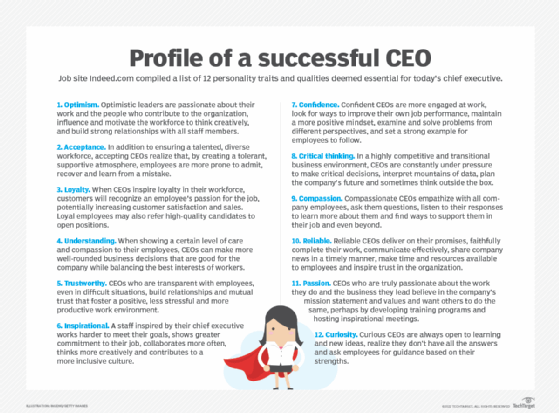
CEO (Chief Executive Officer)
The chief executive officer (CEO) is the top position in an organization and responsible for implementing existing plans and policies, improving the company's financial strength, supporting ongoing digital business transformation and setting future strategy.
The CEO is ultimately responsible for the company's success or failure and oversees its various functions, including operations, finance, marketing, sales, human resources, legal, compliance and technology, while balancing the needs of employees, customers, investors and other stakeholders.
The CEO title most often applies to for-profit businesses whose size in terms of employee numbers or revenue justifies this top position. Some nonprofit organizations also choose to have their most senior person hold the CEO title. Business laws influence whether the title CEO is appropriate within an entity. Corporations, by law, must have CEOs, other chief officers and boards of directors. A limited liability company (LLC) can structure itself like a corporation and have a CEO, but it's not required by the laws governing LLCs.
Additionally, some business and nonprofit entities can have their top leader fulfill the duties of a CEO yet opt for other titles such as president or executive director.
This article is part of
The evolving CIO role: From IT operator to business strategist
CEO roles and responsibilities
Although a CEO's key responsibilities are generally the same from one organization to the next, exact duties can vary based on several factors, including the size of the company and whether it's a public or privately held company. The CEO or owner of a startup or a small family business generally performs more hands-on day-to-day operations and management tasks than the CEO of a large company.
One of the CEO's key tasks is developing, communicating and implementing corporate policies and strategies, determining the company's plan of action in terms of which budgets, investments, markets, partnerships and products, among others, to pursue and implement to best fulfill the organization's primary mission: maximize profits, as is the case in most businesses, or meet specific humanitarian and philanthropic goals, as with nonprofits and some for-profit enterprises.
Other key CEO tasks include organizing leadership and staff to meet strategic goals, ensuring that appropriate governance and controls exist to limit risk and comply with laws and regulations, identifying and delivering value to the various stakeholders, and providing leadership at all times, especially during times of crisis.

Differences between a CEO and owner of a company
CEO is a functional title with daily leadership duties and responsibilities, while ownership is a legal designation.
The board of directors usually selects the CEO, who is the highest-level person, while a business owner is typically the founder, considered the sole proprietor and entrepreneur who owns most or all the company, and in charge of all business functions. In a publicly traded company, the shareholders are the owners and the CEO is an employee held accountable by the shareholders through the board of directors.
The CEO can be the owner, and the owner can be the CEO, so the roles are aren't mutually exclusive. Successful CEOs and owners often possess similar traits, including business acumen, critical thinking, interpersonal communication skills, passion for the job and loyalty to the company. They also may be responsible for filling high-level positions in their organizations.
An owner can play a passive role in the business, providing guidance and advice to the CEO, or a direct role by managing some or all business functions. The CEO almost always has a direct role in the business with responsibility for day-to-day oversight and the company's success or failure.
CEO's role in staff hiring and retention
The CEO is also responsible for hiring C-level members of the executive team and firing those who don't perform up to the standards set by the CEO. These chief officers are tasked with advising the CEO on functional areas, including the chief financial officer (CFO) on financial planning and risk management, chief operating officer (COO) on business operations, chief technical officer (CTO) on technology requirements, chief information officer (CIO) on IT processes, chief marketing officer on marketing and sales, chief data officer on data science and analytics, chief compliance officer on policies and procedures, and chief human resources officer or chief people officer on HR and talent management. These executives help the CEO formulate strategy and implement the policies and directions set by the CEO and are in charge of managing their functional areas on the CEO's behalf.
The CEO is also responsible for promoting the company's culture by helping to determine the attitudes, behaviors and values that best represent the organization's mission, modeling those characteristics, ensuring management's support and recognizing the value and contributions of each employee.
An organization's board of directors generally hires the CEO, determines compensation and evaluates performance. The CEO, who can also hold the position of company president or chairman of the board of directors, is expected to regularly keep the board informed of corporate affairs.
Similar C-suite positions
As a C-suite position, the CEO is part of the executive staff that sets the company's strategy. While most of an organization's lower-ranking employees require technical know-how, C-suite executives must possess leadership and team-building skills. Additionally, C-suite executives often require better business acumen because their decisions have a major influence on an enterprise's overall direction and success. Other C-suite positions include the CFO, COO and CIO.
- The chief financial officer compiles budgets, tracks expenses and revenue, analyzes financial data and reports this information to the CEO. The CFO is also the liaison between the company and banks, money lenders and financial institutions with which the company does business.
- The chief operating officer usually oversees operations and day-to-day functions within the company, particularly when the organization is very large. The COO reports directly to and advises the CEO and works closely with the CFO and CIO.
- The chief information officer manages IT strategy and implementation, overseeing the hardware, software and data that help other members of the C-suite do their jobs effectively. The CIO must research new technologies, strategize how technology can provide business value and address the risks and rewards associated with digital information.
There are other C-suite positions with titles such as chief digital officer, chief data officer and chief marketing officer, but the exact titles and roles vary from company to company. For example, a healthcare organization would require a chief medical officer, and cutting-edge technology companies often employ a chief innovation officer.
Examples of successful CEOs
The best CEOs excel at innovation, disrupting industries, improving the financial success of their companies and bettering the lives of their employees and society. In technology, for example, highly successful CEOs demonstrate a unique vision, longevity and tenacity, at times generate controversy, and eventually attain iconic status as their brands become household names.
Steve Jobs co-founded Apple in 1976 with the mission of contributing to society by making tools for the mind that advance humankind. While CEO of Apple, the company developed breakthrough products such as the Macintosh computer, iPhone and iPad and revolutionized digital music through iTunes. Apple, however, had its share of financial problems in the 1990s and approached bankruptcy partly due to Mac clones cutting into sales. Jobs was brought back as CEO and set about reinventing the computer maker. His ambition and vision transformed Apple into one of the world's most successful and influential companies by the time of his death in 2011. In 2018, Apple became the first publicly traded U.S. company to reach $1 trillion in valuation.
Jeff Bezos walked away from a hedge fund job in 1994 and founded Amazon, which began as an online bookstore operating in Bezos' garage to take advantage of the rapid growth in internet usage. Bezos' vision transformed Amazon into an "everything store" where customers could buy a wide range of products. To optimize the customer experience, the online retail giant offered more book titles than those found in brick-and-mortar bookstores, provided perks like one-click shopping and published good and bad product reviews. These practices are commonplace now, but they were revolutionary in 1997 when Amazon went public. The company entered the grocery business and substantially increased its footprint as a brick-and-mortar retailer with the purchase of Whole Foods in 2017. Amazon is currently the world's largest retailer and marketplace, smart speaker provider and cloud computing service through AWS. Bezos stepped down as Amazon CEO in 2021 to become executive chairman.
Elon Musk, CEO of Tesla and SpaceX, founder of several other businesses, including the company that later became PayPal, and currently negotiating the purchase of Twitter, is said to be revolutionizing transportation on Earth with electric cars and in space with reusable rocket launch systems. Musk joined Tesla as chairman and product architect in 2004 and became CEO in 2008. Tesla introduced the Roadster sports car in 2006, Model S sedan in 2012 and less-expensive Model 3 in 2017, which became the best-selling electric car of all time. Believing that humanity must learn to live on other planets to survive as a species, Musk founded SpaceX as CEO and chief designer in 2002 and set out to make rockets reusable and more affordable. SpaceX's Dragon spacecraft has carried astronauts and supplies to the International Space Station, and the Super Heavy Starship system will eventually carry a spacecraft designed for rapid transportation between cities on Earth and travel to the Moon and Mars.






